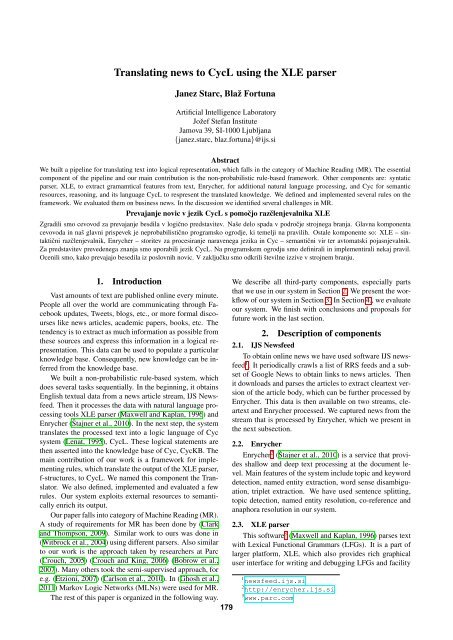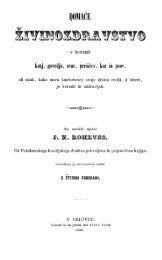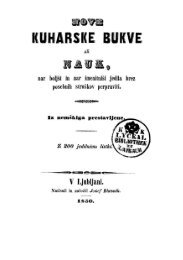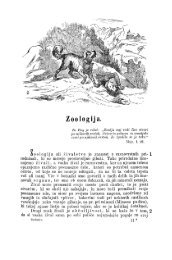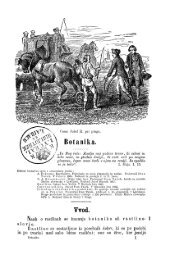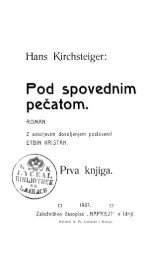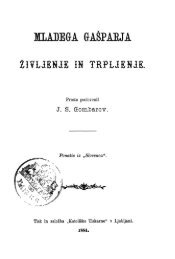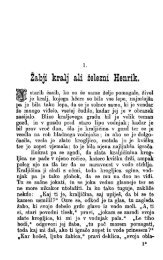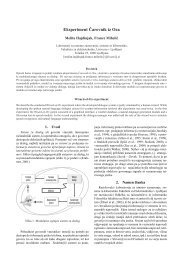Proceedings - Natural Language Server - IJS
Proceedings - Natural Language Server - IJS
Proceedings - Natural Language Server - IJS
You also want an ePaper? Increase the reach of your titles
YUMPU automatically turns print PDFs into web optimized ePapers that Google loves.
Translating news to CycL using the XLE parser<br />
Janez Starc, Blaˇz Fortuna<br />
Artificial Intelligence Laboratory<br />
Joˇzef Stefan Institute<br />
Jamova 39, SI-1000 Ljubljana<br />
{janez.starc, blaz.fortuna}@ijs.si<br />
Abstract<br />
We built a pipeline for translating text into logical representation, which falls in the category of Machine Reading (MR). The essential<br />
component of the pipeline and our main contribution is the non-probabilistic rule-based framework. Other components are: syntatic<br />
parser, XLE, to extract gramamtical features from text, Enrycher, for additional natural language processing, and Cyc for semantic<br />
resources, reasoning, and its language CycL to respresent the translated knowledge. We defined and implemented several rules on the<br />
framework. We evaluated them on business news. In the discussion we identified several challenges in MR.<br />
Prevajanje novic v jezik CycL s pomočjo razčlenjevalnika XLE<br />
Zgradili smo cevovod za prevajanje besdila v logično predstavitev. Naˇse delo spada v področje strojnega branja. Glavna komponenta<br />
cevovoda in naˇs glavni prispevek je neprobabilistično programsko ogrodje, ki temelji na pravilih. Ostale komponente so: XLE – sintaktični<br />
razčlenjevalnik, Enrycher – storitev za procesiranje naravenega jezika in Cyc – semantični vir ter avtomatski pojasnjevalnik.<br />
Za predstavitev prevedenega znanja smo uporabili jezik CycL. Na programskem ogrodju smo definirali in implementirali nekaj pravil.<br />
Ocenili smo, kako prevajajo besedila iz poslovnih novic. V zaključku smo odkrili ˇstevilne izzive v strojnem branju.<br />
1. Introduction<br />
Vast amounts of text are published online every minute.<br />
People all over the world are communicating through Facebook<br />
updates, Tweets, blogs, etc., or more formal discourses<br />
like news articles, academic papers, books, etc. The<br />
tendency is to extract as much information as possible from<br />
these sources and express this information in a logical representation.<br />
This data can be used to populate a particular<br />
knowledge base. Consequently, new knowledge can be inferred<br />
from the knowledge base.<br />
We built a non-probabilistic rule-based system, which<br />
does several tasks sequentially. In the beginning, it obtains<br />
English textual data from a news article stream, <strong>IJS</strong> Newsfeed.<br />
Then it processes the data with natural language processing<br />
tools XLE parser (Maxwell and Kaplan, 1996) and<br />
Enrycher (ˇStajner et al., 2010). In the next step, the system<br />
translates the processed text into a logic language of Cyc<br />
system (Lenat, 1995), CycL. These logical statements are<br />
then asserted into the knowledge base of Cyc, CycKB. The<br />
main contribution of our work is a framework for implementing<br />
rules, which translate the output of the XLE parser,<br />
f-structures, to CycL. We named this component the Translator.<br />
We also defined, implemented and evaluated a few<br />
rules. Our system exploits external resources to semantically<br />
enrich its output.<br />
Our paper falls into category of Machine Reading (MR).<br />
A study of requirements for MR has been done by (Clark<br />
and Thompson, 2009). Similar work to ours was done in<br />
(Witbrock et al., 2004) using different parsers. Also similar<br />
to our work is the approach taken by researchers at Parc<br />
(Crouch, 2005) (Crouch and King, 2006) (Bobrow et al.,<br />
2007). Many others took the semi-supervised approach, for<br />
e.g. (Etzioni, 2007) (Carlson et al., 2010). In (Ghosh et al.,<br />
2011) Markov Logic Networks (MLNs) were used for MR.<br />
The rest of this paper is organized in the following way.<br />
179<br />
We describe all third-party components, especially parts<br />
that we use in our system in Section 2. We present the workflow<br />
of our system in Section 3. In Section 4., we evaluate<br />
our system. We finish with conclusions and proposals for<br />
future work in the last section.<br />
2. Description of components<br />
2.1. <strong>IJS</strong> Newsfeed<br />
To obtain online news we have used software <strong>IJS</strong> newsfeed<br />
1 . It periodically crawls a list of RRS feeds and a subset<br />
of Google News to obtain links to news articles. Then<br />
it downloads and parses the articles to extract cleartext version<br />
of the article body, which can be further processed by<br />
Enrycher. This data is then available on two streams, cleartext<br />
and Enrycher processed. We captured news from the<br />
stream that is processed by Enrycher, which we present in<br />
the next subsection.<br />
2.2. Enrycher<br />
Enrycher 2 (ˇStajner et al., 2010) is a service that provides<br />
shallow and deep text processing at the document level.<br />
Main features of the system include topic and keyword<br />
detection, named entity extraction, word sense disambiguation,<br />
triplet extraction. We have used sentence splitting,<br />
topic detection, named entity resolution, co-reference and<br />
anaphora resolution in our system.<br />
2.3. XLE parser<br />
This software 3 (Maxwell and Kaplan, 1996) parses text<br />
with Lexical Functional Grammars (LFGs). It is a part of<br />
larger platform, XLE, which also provides rich graphical<br />
user interface for writing and debugging LFGs and facility<br />
1 newsfeed.ijs.si<br />
2 http://enrycher.ijs.si<br />
3 www.parc.com


